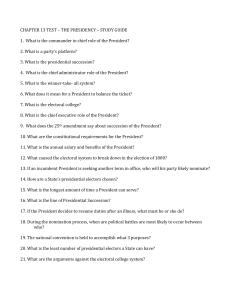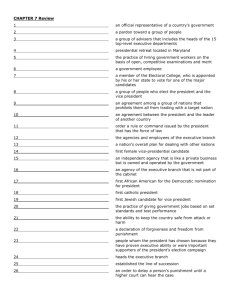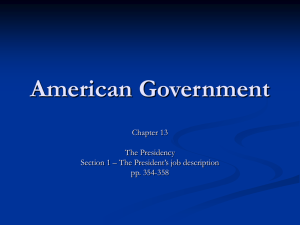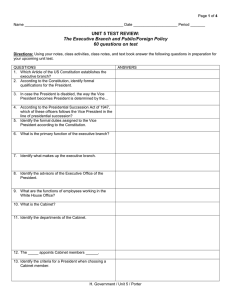Document 11102890
advertisement
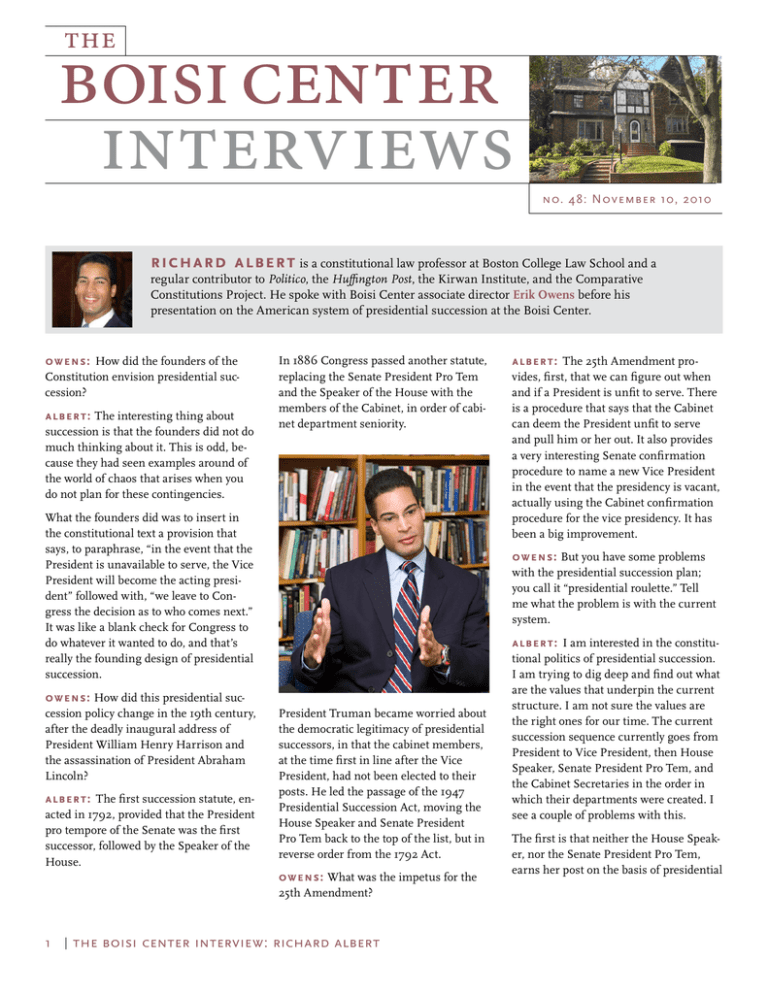
the boisi center interviews no. 4 8: November 10, 2010 richard albert is a constitutional law professor at Boston College Law School and a regular contributor to Politico, the Huffington Post, the Kirwan Institute, and the Comparative Constitutions Project. He spoke with Boisi Center associate director Erik Owens before his presentation on the American system of presidential succession at the Boisi Center. owens: How did the founders of the Constitution envision presidential succession? albert: The interesting thing about succession is that the founders did not do much thinking about it. This is odd, because they had seen examples around of the world of chaos that arises when you do not plan for these contingencies. In 1886 Congress passed another statute, replacing the Senate President Pro Tem and the Speaker of the House with the members of the Cabinet, in order of cabinet department seniority. What the founders did was to insert in the constitutional text a provision that says, to paraphrase, “in the event that the President is unavailable to serve, the Vice President will become the acting president” followed with, “we leave to Congress the decision as to who comes next.” It was like a blank check for Congress to do whatever it wanted to do, and that’s really the founding design of presidential succession. owens: But you have some problems with the presidential succession plan; you call it “presidential roulette.” Tell me what the problem is with the current system. albert: I am interested in the constitu- owens: How did this presidential succession policy change in the 19th century, after the deadly inaugural address of President William Henry Harrison and the assassination of President Abraham Lincoln? albert: The first succession statute, enacted in 1792, provided that the President pro tempore of the Senate was the first successor, followed by the Speaker of the House. President Truman became worried about the democratic legitimacy of presidential successors, in that the cabinet members, at the time first in line after the Vice President, had not been elected to their posts. He led the passage of the 1947 Presidential Succession Act, moving the House Speaker and Senate President Pro Tem back to the top of the list, but in reverse order from the 1792 Act. owens: What was the impetus for the 25th Amendment? 1 albert: The 25th Amendment provides, first, that we can figure out when and if a President is unfit to serve. There is a procedure that says that the Cabinet can deem the President unfit to serve and pull him or her out. It also provides a very interesting Senate confirmation procedure to name a new Vice President in the event that the presidency is vacant, actually using the Cabinet confirmation procedure for the vice presidency. It has been a big improvement. the boisi center interview: richard albert tional politics of presidential succession. I am trying to dig deep and find out what are the values that underpin the current structure. I am not sure the values are the right ones for our time. The current succession sequence currently goes from President to Vice President, then House Speaker, Senate President Pro Tem, and the Cabinet Secretaries in the order in which their departments were created. I see a couple of problems with this. The first is that neither the House Speaker, nor the Senate President Pro Tem, earns her post on the basis of presidential traits or the ability to step into the shoes of the President. Secretaries, to deal with crisis management. Then there are two subsidiary problems. The difficulty with the Senate President Pro Tem as successor is that, typically, he is the Senate elder of the majority party. The past three or four have been 82, 92, 88, and 83 years old, including Robert Byrd, Strom Thurman, Ted Stevens and Daniel Inouye. These are individuals of an advanced age, and we might not want such elderly persons in such demanding positions. owens: So how do we fix the problem? The difficulty with the House Speaker is that she earns her post on the basis of the logrolling and horse-trading that is typical of Washington politics. This might not inspire Americans when they need inspiration the most: following a disaster scenario, such as a terrorist attack on Washington, after which both the President and Vice President are unable to serve. The problem with the order of succession with respect to the Cabinet departments is that they are ordered according to departmental seniority: first, the State Department, and then Treasury and Defense. These people are typically very well qualified for doing not only their role, but also greater roles. Not necessarily the presidency, but we can certainly agree that the typical Secretary of State is going to be more qualified for the presidency than the typical Labor or Transportation Secretary. To be fair, there are exceptions and that may not always be the case. The current Agriculture Secretary, for example, is Tom Vilsack, who is a former candidate for the Democratic nomination for President. Some might say that he is qualified in some ways, maybe minimally for the presidency. The Department of Homeland Security Secretary is the most recently created department and thus its secretary is last in the line of succession. Yet she or he is perhaps the most qualified of all Cabinet Secretaries, save perhaps the State or Treasury or Defense 2 albert: The first change I want to suggest is that we remove the House Speaker and the Senate President Pro Tem from the line of succession entirely. The second is that Congress should pass a statute rearranging the order in which Cabinet Secretaries ascend to the presidency. No longer should it be about departmental seniority; it should be about departmental competence. Perhaps there should be no big changes at the top—leaving the State, Treasury, and “No longer should [presidential succession] be about depar tmental seniority; it should be about depar tmental competence.” Defense Secretaries where they are—but Congress should certainly elevate Homeland Security up the line. The third change is probably the most controversial, but I also think the most important. I would insert former presidents, in reverse chronological order, ahead of all Cabinet Secretaries and behind the Vice President. The former Presidents’ order of succession would also account for party affiliation. Were my plan adopted today, the first successor after the Vice President would be Bill Clinton. It would not be George W. Bush, because Bill Clinton the boisi center interview: richard albert is of the same party as President Obama. The order would be Clinton, Carter, George W. Bush, George H. W. Bush, the currently living former presidents. Secondly, age might admittedly be a concern for some. Maybe people do not think Jimmy Carter is qualified to be President anymore. The concerns that cause us to pause with respect to the Senate President Pro Tem may also cause us to pause with respect to Jimmy Carter. For this situation, I would provide for opt out provisions, much like the 25th Amendment does. I would also exclude former Presidents who have been impeached and convicted, or who have resigned from office. That addresses the Nixon problem, and it also addresses the Clinton problem. Clinton was only impeached, he was not convicted. He might still be President today if he were allowed to run again, were it not for the 22nd Amendment. Finally, what to do about discredited Presidents? Discredited Presidents who may nevertheless have been reelected? Presidents who choose not to run a second time, perhaps because of their standing in the polls? What about what some might regard as the George W. Bush problem? He won twice, but he left office with dismal approval ratings. I would not exclude these individuals because there is something that happens to former Presidents in the post-presidency. They come to be seen as non-political, non-partisan statespersons. In many ways they take on the role of ceremonial presidents that we see abroad in semi-presidential countries. Statespersons who are seen as having the public interest at heart above all else. This is actually borne out by social science data and historical tracking of polls of former Presidents. Their approval rating changes immensely; Bush’s ratings have improved by about 15 to 18 points since his departure from office. [end] The Boisi Center for Religion and American Public Life Boston College 2 4 Quinc y Road Chestnut Hill, MA 02 467 tel 617 - 55 2-1860 f a x 617 - 55 2-1863 publife@b c .e du Visit bc .e du/boisi-resources for a complete set of the Boisi Center Inter views and audio, video, photographs, and transcripts from our events. 3 the boisi center interview: richard albert b oisicenter @b oisi _ center



